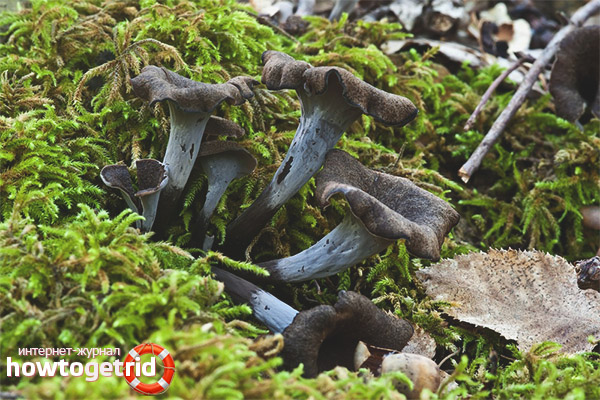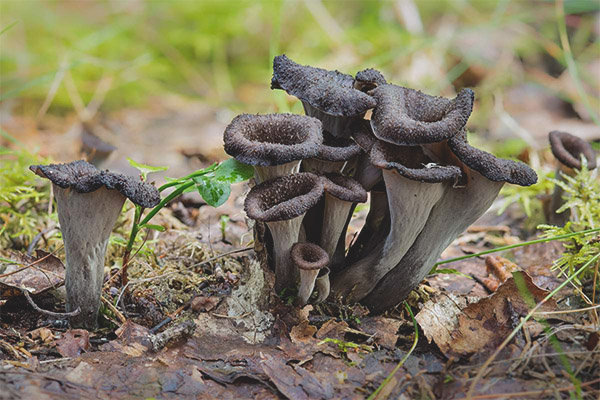The content of the article
For some reason, many are convinced that wonderful things or phenomena are somewhere far away, in foreign lands, and next to them there can not be. So about the seemingly unusual mushrooms they think that they cannot grow in the nearby forest, located behind the house ...
In fact, strange mushrooms can be found anywhere - and in the native wood, including. Only quite often the mushroom picker, having caught sight of an unfamiliar mushroom, calls it a grebe and neglects it. Not knowing that quite often among unfamiliar mushrooms come across edible and tasty.
Description
A fungus called funnel horn grows in the forest (it is also often called the black horn, funnel shaped funnel, horn crater crater). And the mushroom picker he is better known as the black fox. In appearance, it fully justifies the name - indeed, it is very similar to a coal-colored funnel standing on a stem with a hat torn into small scraps (in young mushrooms, the edges of the cap are full and curved).This sad color gives the element contained in the product called melanin.
The height of the mushroom - 10 centimeters.
The cap is the inside of the funnel, is the surface of a gray-black color, if the mushroom is young, then the presence of a brownish shimmer is necessary, the diameter is 3-6 centimeters. From the outside of the gray-white color, all covered with tubercles, wrinkled. When disputes ripen, it becomes a gray color. When welded, it becomes coal black.
The stem is very short - 8 millimeters long, tapers towards the base, the color is the same as that of the cap. The flesh is grayish-ash, delicate, the structure is thin, the taste is mushroom, it smells like fresh mushrooms, the flavor of dried mushrooms is even stronger.
Locations
Black fox grows mainly in deciduous, less often - mixed forests of the temperate zone in the territories of Eurasia and North America both on the plains and in the highlands. Prefers open to light moist soil rich in limestone and clay, under beeches, maples, hazel and oak trees, using fallen leaves as soil and humus. It grows in large groups, forming whole colonies.Growth begins in early summer, with the onset of the first month of the year until the end of autumn, the greatest harvest can be harvested in late August - early September.
Edibility

Of the many species of chanterelles growing in the forest, the horn-like funnel can be considered the most delicious mushroom. Although it belongs to the last - the fourth flavor category, but in some countries of Western Europe (France, England), on the North American continent (in Canada) it is considered to be the same delicacy as rare morels or truffles. For dishes they use only a mushroom cap (funnel), because the legs are rather coarse, rubbery (badly chewed) and not very tasty. Hats are cleaned of soil and other forest litter, dried for winter or washed in copious amounts of water, and then fried - either individually or with vegetables and potatoes, cooked nutritious soups, and stewed. Black chanterelles make very fragrant and tasty sauces. Dried mushroom (by the way, the pulp of dried black chanterelles becomes lighter when dried) is ground into powder and used as a seasoning.Also horn funnel, like other types of chanterelles, is eaten raw, sprinkled with salt.
Similar species
Other name Voronochnika
This unusual mushroom is very much like musical instruments - a pipe protruding from the ground or a horn. True, their appearance is rather frightening and depressing. Therefore, the Germans call this tasty, but having an awesome mushroom "pipe of the dead." In England and in France, the attitude towards the mushroom is more loyal and supportive, the French, along with the British, simply call it with taste, the “cornucopia”. In Finland, they didn’t come up with anything too much and called the funnel the “black horn”.
Medical use and properties
In the funnel a lot of phosphorus, contains calcium and a little potassium. Mushroom is very well suited for those who are on a diet - its protein content is only 28%. And the contained polysaccharides can prevent sarcoma from growing, if it exists.











To send